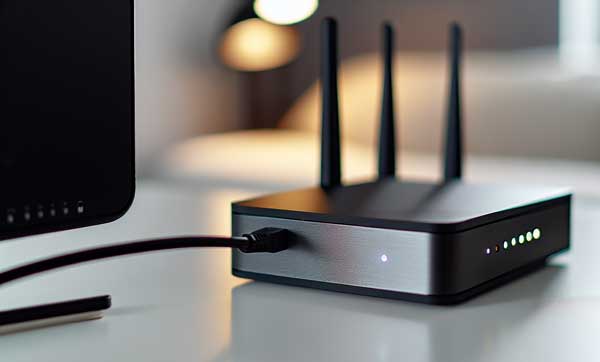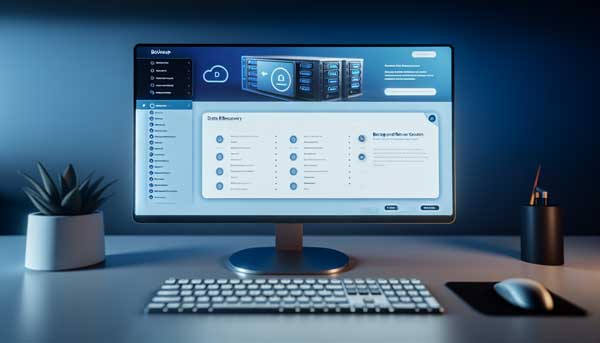Set up your own cloud at home step by step
- Details
- Hits: 4186
Everyone in the office was yesterday. Home office is still today. Anyone who has set up a home office extends its use to the private sector. For example, do you want one? own cloud at home There are a few things to consider when setting up your system and becoming independent of external providers. This article shows you the essential steps private clouds Set up – quickly, safely and without losing quality or functionality.

Contents
- Key facts at a glance
- Private Cloud: The ideal solution for your data
- Options for setting up a private cloud
- Step-by-step instructions for setting up a private cloud
- Five beginners' tutorials for NAS
- Manage and optimize your private cloud
- Alternatives and additions to the private cloud
- Frequently asked questions
Key facts at a glance
- A private cloud offers increased security, control and flexibility for data and services, and can be a cost-effective, self-managed alternative to large-scale cloud computing Cloud providers represent.
- Stand for setting up a private cloud different options like external hard drives Router, NAS systems and Raspberry Pi are available, which offer different functions and levels of performance depending on your needs.
- Managing a private cloud involves regular Data backup processes to protect against data loss, updates and maintenance, as well as the ability to scale and expand resources to meet the needs of the business.
Private Cloud: The ideal solution for your data
Imagine having full control over your data. You know exactly where they are stored and who has access to them. This is possible with a private cloud. It not only offers increased security, but also a high level of security Control and flexibility about your data and services.
Whether you run a small business or just want to keep your personal files safe and organized, a private cloud is the ideal solution for you. It is safe, flexible and completely under your control. And the best part? You can easily set it up yourself, even as Alternatives to Google Drive!
What is a private cloud?
A private cloud is more than just a collection of data on a server. she is a efficient service, which is available exclusively to select users and gives you advanced control and customization options. But what makes them so special?
 How do you set up an ergonomic computer workstation?
How do you set up an ergonomic computer workstation?
Firstly, a private cloud offers a higher level Security and privacy, as it uses dedicated resources and local hosting infrastructure. Secondly, it enables virtualization, which means that applications can be operated virtually in the cloud. Finally, your own cloud at home is a serious alternative to large cloud service providers as it allows for cost savings, improved data security and local server location.
Why choose a private cloud?
You may be wondering why you should choose a private cloud when there are so many public cloud services out there. The answer is simple: private clouds offer complete control over data and IT infrastructure and thereby increase data security.
With a private cloud you have the opportunity to own security protocols to protect your data from security breaches. In addition, the private cloud offers an ideal solution for companies that value high performance and absolute system control. And finally, setting up your own private cloud ensures data sovereignty and independence from large providers.
Options for setting up a private cloud
 Now that you know the benefits of a private cloud, you may be wondering how to set one up. There are various options to choose from, such as external hard drives on the router, NAS systems and Raspberry Pi.
Now that you know the benefits of a private cloud, you may be wondering how to set one up. There are various options to choose from, such as external hard drives on the router, NAS systems and Raspberry Pi.
Each of these options has its own advantages and disadvantages.
- external hard drives on the DSL router are a cost-effective and simple solution.
- NAS systems offer advanced features.
- Raspberry Pi is a flexible and powerful option.
Below we will look at each of these options in more detail.
External hard drive on the router
Using an external hard drive on the router is a simple and reduce your recruitment coststhe way to your own cloud on the DSL router. This method is particularly suitable if you only need to store a limited amount of data and do not need advanced features.
Many modern routers have this USB ports, which allow the connection of external hard drives and have built-in network sharing functions. The connected external hard drive is set up to be accessible over the local network as a simple form of private cloud.
NAS systems
NAS systems (Network Attached Storage) are special devices designed to store and share data on the network and can be used as personal cloud servers. Compared to simple external hard drive solutions, they offer additional functions such as user management, automatic backups and media server functionalities.
When using NAS systems, it is important that they have a remote accessoffer an opportunity. This is usually made possible via DynDNS services, which enable access from outside your own network.
Raspberry Pi
Another option for setting up a private cloud is to use a Raspberry Pi. This small, inexpensive computer can be more powerful cloud server .
Nextcloud and Owncloud are two Open Source-Projects that can be installed on the Raspberry Pi to securely share data and facilitate collaboration. However, please note that setting up a Raspberry Pi as a cloud server requires technical expertise.
Step-by-step instructions for setting up a private cloud

Now that you know the different options for setting up a private cloud, it's time to dive deeper and actually create one. Setting up a private cloud requires one stable internet connection and a router that is constantly running, as well as solid PC skills.
Below is a detailed step-by-step guide on how to set up a private cloud at home as an example Raspberry Pi. This guide will walk you through all the necessary steps, from preparation and installation to access and security.
Preparation
Before you can start setting up your private cloud, you first need to take care of the necessary hardware. You need:
- a Server & Hostingsystem, such as a Raspberry Pi
- a Housing for the Raspberry Pi
- a Power Supplies for the Raspberry Pi
- a LAN cableto connect the Raspberry Pi to your network.
You also need enough storage space for your cloud data. For this you can use an external hard drive or a Micro SD card use. When choosing the Micro SD card, it is important to pay attention to high read and write speeds to optimize file processing performance.
Installation and configuration
After the preparation (including installing the operating system), comes the most important part of setting up your private cloud: installation and configuration. This includes setting up a database server, configuring a web server and installing cloud software.
For the PHP- and database functionalities of the cloud software, additional packages are necessary. To set up the database server, the following packages must be installed:
- php8.2-fpm
- php8.2 mysql
- mariadb server
- mariadb client
Access and security
After installing and configuring your private cloud, you need to make sure you can access it and that your data is safe. Access management in your own private cloud makes it possible to individually determine who has which rights.
To assign access rights to database resources, security-relevant database users and corresponding rights must be created. In addition, you should have one SSL connection set up to ensure the security of data transmission.
Five beginners' tutorials for NAS
Using the example of a Synology NAS server, we will show you step by step how to assemble, install, set up and secure it. This is one smooth start guaranteed in the world of NAS servers.
Unboxing
Assemble and wire the disk station
Diskstation Manager and first administration account
Set up the first storage pool
Make security settings
Manage and optimize your private cloud
Once you've set up your own private cloud, it's important that you manage and optimize it effectively. Effective private cloud management involves ensuring business continuity automatic Backup and restore options that can minimize data loss.
Below we'll take a closer look at how you can manage and optimize your private cloud, including data backup and recovery, updates and maintenance, and scaling and expansion.
Data backup and recovery
 Data backup and recovery are critical aspects of managing your private cloud. NAS systems offer automatic backup functions, which can back up data from various devices, including photos, once a device is connected to the cloud, such as:
Data backup and recovery are critical aspects of managing your private cloud. NAS systems offer automatic backup functions, which can back up data from various devices, including photos, once a device is connected to the cloud, such as:
- Windows PCs
- Macs
- Smartphones
- Tablets
It is important to create regular backups of key management components and perform automatic backups before updates. Restoring data in the private cloud should be easy to perform in order to quickly respond to data loss.
Updates and maintenance
Regular updates from Cloud software are critical to private cloud security and performance. Additionally, scheduled maintenance should be performed, which is fundamental to the long-term performance and security of a private cloud.
During maintenance, special adjustments may be necessary, such as disabling DRS rules or removing CD inserts from VMs, to ensure smooth operations.
Scaling and expansion
Private clouds can scale and expand to keep pace with your business' growing needs. Private clouds can be particularly effective when it comes to dynamic workload requirements by individually adapting the Storage capacity and computing power achieve lower total cost of ownership.
By using capacity planning tools and automation mechanisms, companies can simplify management and reduce costs in a private cloud.
Alternatives and additions to the private cloud
Although the private cloud offers many advantages, there are also some alternatives and additions that should be considered. These include online cloud hosts, hybrid clouds and the multi-cloud strategy.
Below we will take a closer look at these alternative paths and explain how they can complement or replace the private cloud.
Hybrid clouds
A hybrid cloud is one Combination from private and public cloud services, which acts as a cloud solution. It enables companies to manage workloads across different cloud infrastructures.
Hybrid clouds can offer companies various advantages:
- Cost savings because you only pay for the resources actually used
- Increasing efficiency
- Greater cybersecurity through local storage of sensitive data
Multi-cloud strategy
A multi-cloud strategy offers Flexibility by using different cloud providers and minimizing dependencies on a single provider. Companies can leverage the specific benefits of different cloud infrastructures to meet individual business needs, such as compliance and performance.
Additionally, a multi-cloud environment promotes innovation through access to a wide range of tools and services from different providers.
Summary
Setting up your own private cloud can be an exciting and rewarding experience. It gives you the control and flexibility you need to manage your data and content securely and efficiently. From choosing the right hardware and software to setting up and managing your private cloud, we've shown you how. Now it's up to you to take the next step and set up your own private cloud.
Regardless of whether you choose an external hard drive on the router, a NAS system or a Raspberry Pi, the advantages of a private cloud are obvious. It offers increased security, full control and flexibility and is ideal for anyone who wants to keep their data safe and organized.
Frequently asked questions
Which cloud is the best for private use?
Google Drive is overall one of the best cloud storage for private individuals, although in the free version file sharing cannot be password-protected or time-limited.
How do I create a private cloud?
To create a private cloud, you install cloud software on a private cloud server and access it from other computers Company network towards it to utilize storage and computing power.
How much does a private cloud cost?
A private cloud can vary depending on the provider and storage size between €15 and €240 cost per year. Your individual needs and priorities will determine what cost is appropriate for you.
How does a private cloud work?
A private cloud works by hosting the IT infrastructure through private data centers, allowing companies exclusively own server resources use it and do not share it with others. This allows isolated access for a single customer and is typically hosted locally in the customer's data center.

Jens Struck is a business owner, journalist and web designer at German Online Publisher GbR in Ried.
